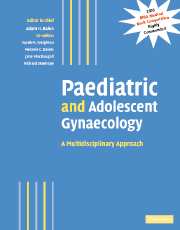Book contents
- Frontmatter
- Contents
- Contributors
- Preface
- Part I Normal development
- 1 Embryology of the female genital tract
- 2 Molecular genetics of gonad development
- 3 Gonadotrophin receptors
- 4 Normal childhood, puberty and adolescence
- 5 Control of the menstrual cycle and fertility
- 6 Nutrition and reproductive function
- 7 Normal bladder control and function
- 8 Development of sexuality: psychological perspectives
- Part II Management of developmental abnormalities of the genital tract
- Part III Management of specific disorders
- Index
- Plate section
- References
6 - Nutrition and reproductive function
from Part I - Normal development
Published online by Cambridge University Press: 04 May 2010
- Frontmatter
- Contents
- Contributors
- Preface
- Part I Normal development
- 1 Embryology of the female genital tract
- 2 Molecular genetics of gonad development
- 3 Gonadotrophin receptors
- 4 Normal childhood, puberty and adolescence
- 5 Control of the menstrual cycle and fertility
- 6 Nutrition and reproductive function
- 7 Normal bladder control and function
- 8 Development of sexuality: psychological perspectives
- Part II Management of developmental abnormalities of the genital tract
- Part III Management of specific disorders
- Index
- Plate section
- References
Summary
Introduction
Optimum fertility requires an adequate level of maternal nutrition. Women who conceive while underweight, usually it must be admitted through medical treatment, have a higher than normal risk of producing a premature child that is itself underweight (van der Spuy et al., 1988). Recent epidemiological studies have indicated that subnormal weight at birth is associated with an adverse pattern of health during adult life, particularly with respect to the development of metabolic and cardiovascular disorders (Barker, 1997). Clearly, then, risks to normal intrauterine development are greater during times of maternal starvation than when nutrition is normal. At the other end of the scale, obesity is associated with impaired health at all ages (Norman and Clark, 1998). Obesity impairs most aspects of fertility, causes insulin resistance and is a major determinant for the expression of polycystic ovary syndrome.
Role of leptin
We now understand that nutrition is regulated in large part by hormonal signals from fat cells interacting with the neuroendocrine system to control feeding and energy expenditure (Kalra et al., 1999). Leptin is a recently discovered cytokine, encoded by the ob gene, that is secreted by white fat cells in response to a number of influences (Mantzoros, 1999). Stimulation of hypothalamic leptin receptors suppresses neuropeptide Y production and thereby controls a variety of reproductive and vegetative functions. Much recent work has focused on factors determining circulating leptin concentrations in an attempt to understand better the influence of fat cell repletion, that is, of nutritional “status”, on reproductive function.
- Type
- Chapter
- Information
- Paediatric and Adolescent GynaecologyA Multidisciplinary Approach, pp. 59 - 64Publisher: Cambridge University PressPrint publication year: 2004



